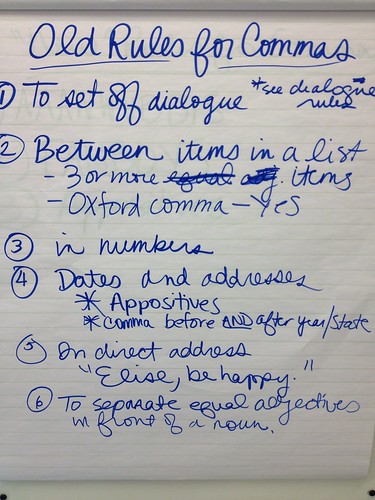Several years ago, a fellow teacher was asked by a parent if her son knew "where the commas go." This was repeated to me later, and I don't remember the details, but that question sticks with me: "Does my child know where the commas go?" It is the kind of question that often gets asked when someone is objecting to writing workshop, or to a lack of grammar worksheets and tests.
At the time, my students and I would joke that there are at least ninety-nine rules for where the commas go. Some are easy, and others are super challenging, some automatic, others up for debate.
Last year I shared grammar duties for 8th grade with another teacher, so to keep things straight we made two charts: Old Rules for Commas and New Rules for Commas. We expected our students to apply the old rules without fail, every single time. Like the editing checklists we had used previously, we expected students to independently find and fix any mistakes related to the old rules. Our other list, the new rules, were the rules we were still learning and practicing. They might get those wrong, but they were working on them. The rules themselves are nothing fancy to start; I know from reading Mechanically Inclined that Jeff Anderson used them with fourth graders. Many students master the new rules quickly, while others need a few more weeks. That's okay.
(An 8th grader close to graduating once confessed to me that he didn't understand the difference between to, too, and two. It happens. It's never a mistake to spend 5 minutes reviewing something you only think everyone already knows.)
Yesterday my students gathered on our imaginary rug, and we made our lists of old and new rules. For now, I kept rules relating to phrases and clauses on the new list; I'm not convinced that those rules are automatic enough for everyone. Our old rules are so basic that I won't feel guilty expecting perfection in using them.
 |
| Yes, this is how messy a chart is when I make it in class. |
Later today I will take the lists that I made with each section, and make a chart with some details and examples for each rule. Students will copy that chart into their Writer's Notebooks. And when we revise and proofread, I'll point to the old list for commas and say "Make sure you follow these rules!"
 |
| Go ahead, pin this. I dare you. |
This year I put "new" in quotes. They worked on AAAWWUBBIS and FANBOYS last year, but I want to revisit them before we move on. Each rule will get a page in their notebooks, with examples, and they'll write their own sentences on the facing page, another idea adapted from Mechanically Inclined. This way, when someone doesn't know how to punctuate something, they can either look at the wall or in their notebook. When we start working in our Killgallon book (Grammar for Middle School: A Sentence-Composing for Approach), we'll add those sentence types, and their comma rules, too.
How do you teach commas in your classroom?
No comments:
Post a Comment